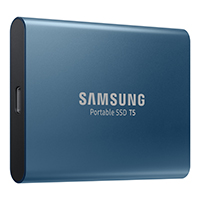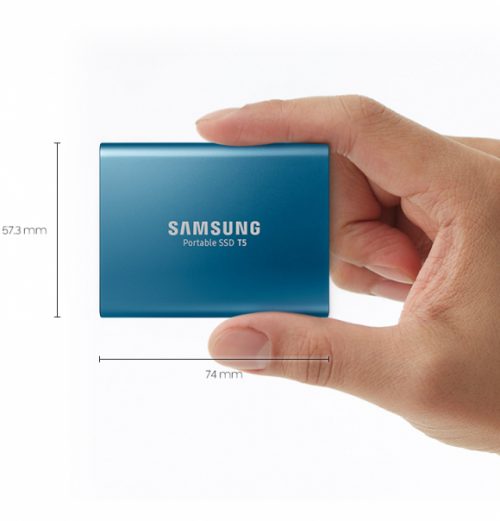Samsung recently announced the newest addition to their SSD family: the Samsung SSD T5. With a lightning fast transfer speed of up to 540 MB/s and storage capacity of up to 2TB, it may be just what we photographers are looking for. Samsung has also added some eye-catching features to their newest creation, providing photographers and videographers alike with a potentially helpful new tool.

Samsung SSD T5 Specifications
The T5 offers:
- 4 different storage options: 250GB, 500GB, 1TB, or 2TB
- Portability: it weighs 51 grams and is relatively tiny in size (3.0 x 2.3 x 0.4 inches)
- 2 connection cables: USB-C to C and USB-C to A (more information about this in the next section)
- No moving parts
- A shock-resistant internal frame
- The ability to withstand drops of up to 2 metres
- Data encryption
- A mobile app for Android users
So What Can the Samsung SSD T5 Do For You – the Upside?
All in all, the T5 offers photographers a chance to travel smoothly and safely with their work.
Since it can withstand significant drops, the T5 is ideal for people who travel a lot and wish to avoid accidentally damaging their files in the process. Also, it won't take up much space, giving bulkier items a chance to fit into your camera bag.
Its speed will allow room for quick file transfers and users will be able to work on their images without having to import them. The connection cables are compatible with almost any modern device. Unless you have gadgets that aren't available in the market right now, you'll be able to connect them to the T5 without a problem. Data encryption will let you easily secure your SSD and keep everything in it safe.

How Much Does It Cost – the Downside?
As mentioned earlier, there are four different versions of the T5, available in 2 colours: Deep Black and Alluring Blue. Deep Black represents the 1TB and 2TB models, while Alluring Blue represents the 250GB and 500GB models. The prices are as follows:
$129.99 for 250GB
$199.00 for 500GB
$399.99 for 1TB
$799 for 2TB
Compared to other hard drives, the T5 has seemingly ridiculous prices. However, if you take its lightning speed, portability, and size into consideration, the cost might make a little more sense – but you will need to weigh-up features vs price. Being able to store your photography files in the Samsung SSD T5 may sound like an incredible investment to some, and a horrible waste of money to others.
Whether it proves to be a success in the long term or not, the T5 is certainly revealing tremendous progress in technological advancement.
Would you invest in Samsung's SSD T5? Share your thoughts with us in the comments!
Further reading on the Samsung SSD T5:





4 Comments
It seems overly pricey. I suppose the price will drop after Samsung recovers its development costs. The question I have is do you for transfer it from the camera to the SSD? If so then how do you work on the files? Do they have to be transferred a second time? Also, if you had filed already on the SSD and deleted some and later added larger filed, would the SSD become severely fragmented? Would that create problems?
I am happy that Samsung has taken the first swing in this market. In my mind this will open up competition once all the rich gadget boys snap up enough to get the market salivating. Think I’ll hide and watch until a cheaper alternative with possibly even more bells and whistles come along. A built in SD slot would be nice. Are you listening Kingston, Western Digital etc?
I already did invest in them, and they are great.
One upside is no “heads” or spinning discs – they are solid state, so there’s less worry about data loss.
One downside is that periodically they need to be thoroughly cleaned out, or they choke up – I came across one article saying you’d have problems with changing data into & out of “drives like this” after about 5-6 years, but there are solutions that enable you to keep extending the life of them, by a full clean out, apparently. More of an issue if you ARE constantly changing what’s recorded on them. I don’t have the technical explanation, but it sounded as though constantly overwriting old data with new stuff chokes up the system, somehow, eventually.
If you just store data files (in my case, photos) on them and use them solely as storage, it doesn’t seem to be a problem. And so easy to use, so convenient, and take up hardly any space (unlike WD’s disc drives with similar capacity).
I am using a T2 I believe. Love it, what I wouldn’t give for a 2T T5 😉